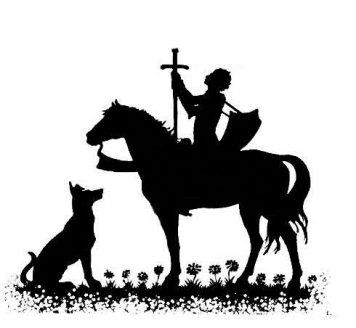A short history of The Blue Pilgrims
The fellowship dates its beginnings to the Whitsunday walk in 1902. The call to serve has led to many places and activities:
- In 1912 Help went to Staffordshire in response to the Miners Strike.
- Through the First World War the Fellowship set up ‘Home huts’ in or near Army barracks for recreation, refreshment and prayers. It was at this time that the Pilgrims first wore the sky blue veils and pilgrim bags by which they became recognised and so gained their name ‘Blue Pilgrims’.
- In 1928, during the Depression, Staffordshire was revisited and visits were made to Wales, where there was great need. A small permanent centre of prayer and encouragement was established at Llantwit-Major. The link with the Welsh valleys remains to this day and present day Knights live at Llantwit.
- Links then became more international and from 1934 Camelots were held in Austria.
- This led on to a major quest in 1938 to rescue a group of Austrian refugees and bring them to the UK.
- In 1949, under the leadership of Knight Una, visits of reconciliation were made to West Germany and the Netherlands. This led to the formation of a strong Continental Company – now small in number but praying about the future.
- One of the most recent quests for reconciliation is in Northern Ireland where support was given to the first integrated Protestant-Catholic school in Belfast – Lagan College, and is now given to The Corrymeela Community’s work in Belfast.
- Since the beginning of the new millennium a group has grown in Bangladesh – a Knight has lived and worked in the country for over 50 years and her example has inspired others to take up the challenge and ‘By love, serve’

Location
For many years the Knighthood family had a base at The Chantry in Sevenoaks, but this had to be sold, and since 1982 the Fellowship has continued without a central home. However a Knighthood home is wherever a Blue Pilgrim lives and works and shares the joy of belonging to the family. For our annual Assembly, and for regional and International Camelots, we use Retreat houses, as the early fellowship did.
Charity Status
In 1948 the Fellowship became a charity and a company limited by guarantee and had to adopt an organisational structure. After prayer, deliberation and much hard work, on 6 November 2025 the Foundation became a Charitable Incorporated Organisation (CIO) and is now to be known as The Beatrice Hankey Foundation CIO. We are registered with the Charity Commission in England and Wales and our charity number remains 211093. Under our new constitution the Beatrice Hankey Foundation Council now consists of the Leader and Treasurer (ex officio) and eight other Council members elected by the members of the Foundation. The Council deals with the financial aspects of the Fellowship as we continue the work of Beatrice and Eva Hankey through the Knighthood/Blue Pilgrims .
The Knighthood Council helps set the direction of the Fellowship. Both Councils meet together once a year to pray and plan together.
Constitution of a Charitable Incorporated Organisation with voting
members other than its charity trustees
More information here